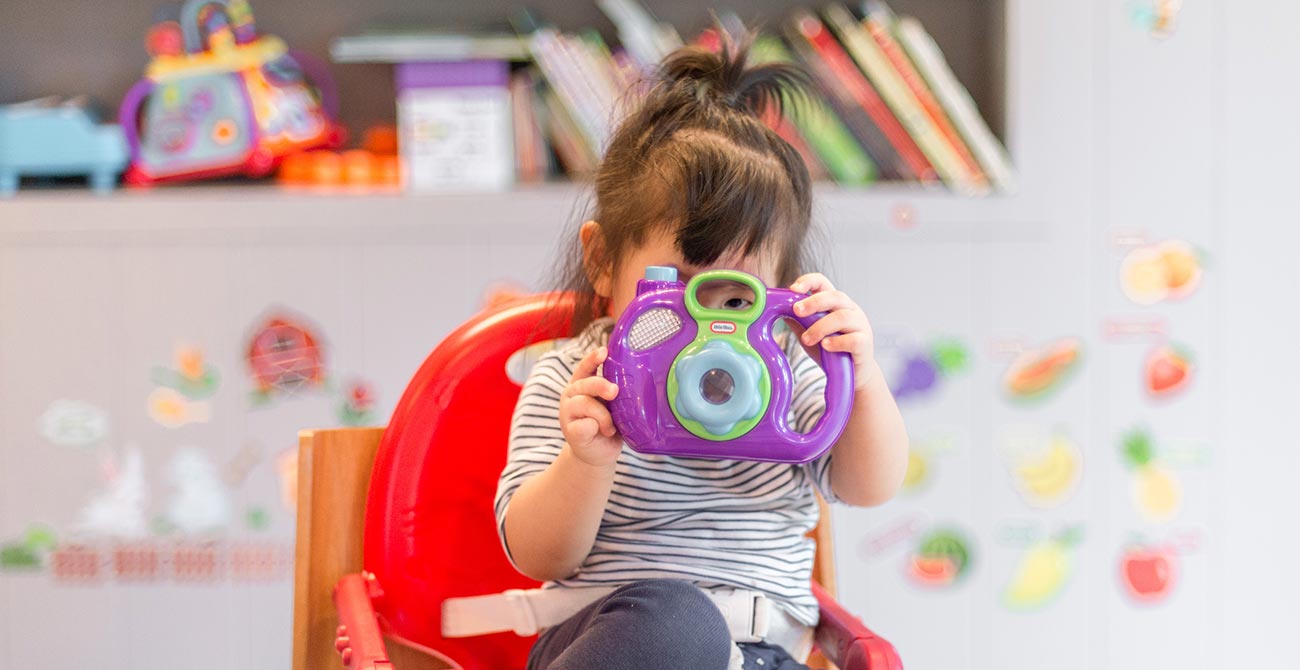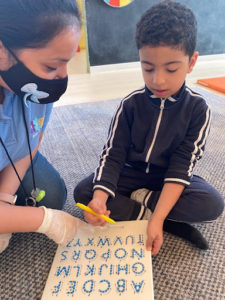
كيفية مساعدة طفلك على البقاء مُركّزًا ومُنظّمًا من خلال التكامل الحسي
مع أخصائية العلاج المهني، فريتيكا روهاتجي، MOT | BOT | RBT

الهدف الرئيسي من النظام الغذائي الحسي هو منع الإرهاق الحسي والعاطفي من خلال تلبية الاحتياجات الحسية للجهاز العصبي. إن فهم الخصائص الحسية للطفل والأنشطة التي تُعزز الهدوء والتنظيم يُمكن أن يُساعده كثيرًا عندما يشعر بالإحباط أو الإرهاق.
إن إشراك الأطفال في تجارب حسية بانتظام يُعزز تركيزهم وانتباههم وتفاعلهم. قد يشعر الأطفال بقلق أقل عندما يشعرون بالراحة.
عادةً ما يُصمّم المعالج المهني (OT) نظامًا حسيًا. يمكن للوالدين ومقدمي الرعاية استخدام الأنشطة المُصمّمة خصيصًا في المنزل؛ ويمكن للمعلمين والمساعدين التربويين استخدامه في المدرسة. يُنصح باستشارة معالج مهني ذي خبرة في مشاكل المعالجة الحسية لأن أحد أصعب جوانب صعوبة الحسية هو إدراك متى يكون الطفل مفرط النشاط أو قليل التفاعل في أي لحظة، ثم تعديل المُدخلات الحسية لتناسب حالته، وتوفير التحدي المناسب لمساعدته على المضي قدمًا نحو حالة "مثالية".
يُستخدم علاج التكامل الحسي لمساعدة الأطفال على تعلم استخدام جميع حواسهم معًا، أي اللمس والشم والتذوق والبصر والسمع. والنظام الغذائي الحسي هو خطة مُصممة خصيصًا للأنشطة البدنية والتكيفات المُصممة لتلبية احتياجات الطفل الحسية.
الأنظمة الحسية المختلفة:
- البصرية- هي المسؤولة عن الرؤية.
- سمعي- المسؤول عن السمع.
- اللمس: مسؤول عن معالجة معلومات اللمس من الجسم. يُعدّ نظام اللمس بالغ الأهمية لدى الأطفال الذين يعانون من اضطرابات المعالجة الحسية. يُعاني العديد من المصابين بهذا الاضطراب من أعراض لمسية، مثل الخجل اللمسي أو ضعف الاستجابة للمس والألم. يُعدّ نظام اللمس أحد الأنظمة الأساسية الثلاثة المستخدمة في علاج التكامل الحسي.
- التذوق- المسؤول عن حاسة التذوق.
- الشم- المسؤول عن معالجة الرائحة.
الأنشطة الموصى بها لنظام غذائي حسي
بعض الأنشطة تُعنى بأنظمة حسية مُحددة. كما تختلف الأنشطة باختلاف العمر، ومستوى المهارة، والأمراض المُصاحبة الأخرى. إليك بعض الأمثلة على الأنشطة التي يُمكن استخدامها كجزء من نظام غذائي حسي:
الحس العميق
يمكن تحقيق المدخلات الحسية العميقة من خلال رفع ودفع وسحب الأشياء الثقيلة. إليك بعض الأفكار:
- دفع عربة الأطفال أو العربة.
- سحب عربة مليئة بالأشياء.
- حمل حقيبة الظهر.
- لعب لعبة الحجلة.
- سباحة.
- عناق قوي.
- المشي مع الحيوانات.
الدهليزي
يُنشأ المُدخل الدهليزي (إحساس الحركة) من أي نوع من الحركة، كالدوران أو التأرجح. إليك بعض الأفكار:
- التأرجح على الأرجوحة.
- مستلقيا في أرجوحة.
- التدحرج.
- القفزات.
- النزول على الشرائح.
- ركوب الدراجة/الدراجة ثلاثية العجلات.
لمسية
تستشعر حاسة اللمس اللمس الخفيف، والضغط العميق، والملمس، ودرجة الحرارة، والاهتزاز، والألم. إليك بعض الأفكار:
- الرسم بالرمل أو الملح.
- تدليك اليد.
- خمسة عالية.
- العب باستخدام معجون العلاج، وكرات الضغط، وشريط لسحبه.
- الكروشيه أو الحياكة أو الخياطة.
- اللعب الفوضوي باستخدام كريم الحلاقة أو الصابون الرغوي.
-
الجلوس/اللعب على حصائر ذات ملمس مختلف
- استخدام كتب ذات ملمس مختلف
سمعي
المدخلات السمعية هي ما نسمعه وكيف نستمع. إليك بعض الأفكار لتهدئة وتنظيم المدخلات السمعية:
- الاستماع إلى الموسيقى.
- الاستماع إلى الأصوات في الطبيعة.
- استخدام سماعات الرأس التي تعمل على إلغاء الضوضاء لتخفيض الصوت.
- العزف على آلة موسيقية.
- الاستماع إلى صوت المياه الجارية.
- قم بتبسيط اللغة عند إعطاء التعليمات لطفلك أو في الفصل الدراسي.
- إعطاء تحذير لفظي أو بصري قبل الأصوات العالية (مثل تدريبات الحرائق) لتغطية الأذنين.
مرئي
قد تكون بعض البيئات مُحفِّزة بصريًا بشكل مفرط، مثل الفصول الدراسية ذات لوحات الإعلانات المزدحمة، أو الغرف ذات الإضاءة الساطعة، أو الألوان الزاهية أو النقوش المزدحمة على الجدران أو الستائر. لتقليل التحفيز البصري:
- يحافظ على المناطق منظمة وخالية من الفوضى
- تخزين العناصر في صناديق أو صناديق
- تجنب استخدام الإضاءة الفلورية
- استخدم ألوان الطلاء المحايدة
يشم
شمُّ روائح معينة قد يُحفِّز الشخص، أو يُهدِّئه، أو يُسبِّب له إرهاقًا حسيًا. عندما يتعلق الأمر بالروائح، فكِّر في:
- استكشاف الروائح المهدئة لاختيار الأنسب. اللافندر والفانيليا والياسمين والورد أمثلة على الروائح المهدئة.
- استنشاق الأعشاب والتوابل المختلفة.
- بعض الناس لا يحبون الروائح إطلاقًا. ابحث عن منتجات غير معطرة، مثل المنظفات والصابون والشامبو.
ذوق
عندما يتعلق الأمر بالتذوق، جرّب نكهات مختلفة. المعالجة الحسية الفموية لا تقتصر على التذوق فحسب، بل تشمل أيضًا اللمس والحس العميق.
- يمكن للمذاق القوي أن يحفز الطفل غير الحساس.
- أشرك الأطفال في تحضير الطعام لزيادة احتمالية تجربتهم لأطعمة جديدة.
- قدم الأطعمة المقرمشة مثل الخضروات النيئة، والفشار، والبريتزل، والتفاح لأولئك الذين يحبون المضغ.
- بالنسبة للطفل الذي يحب المضغ، استخدمي المجوهرات القابلة للمضغ.
- ومن الأفكار الأخرى للأطعمة المطاطية: جلد الفاكهة، أو لحم البقر المجفف، أو أعشاب من الفصيلة الخبازية، أو الزبيب.
- بالنسبة للأطفال الذين يحبون مص أو لعق الأشياء، جربوا المصاصات، أو مكعبات الثلج، أو الشرب من خلال القشة.
هذه بعض الأنشطة الاختيارية التي يُمكن استخدامها لإنشاء نظام غذائي حسي. للاطلاع على بعض الأمثلة، انقر على هنامن المهم العمل مع معالج مهني ذي خبرة لا يستطيع فقط إنشاء نظام غذائي حسي، بل يمكنه أيضًا المساعدة في الدعم البصري وجدولة الأنشطة طوال اليوم.
إذا كنت تشعر أن طفلك يواجه صعوبة في مهاراته الحركية، فننصحك باستشارة معالج مهني يمكنه وضع خطة مُخصصة لتحسين سلوك طفلك. يمكنك التواصل معنا على الرقم 39006065 أو مراسلتنا عبر البريد الإلكتروني info@reachabatherapy..com للحصول على استشارة مجانية.

